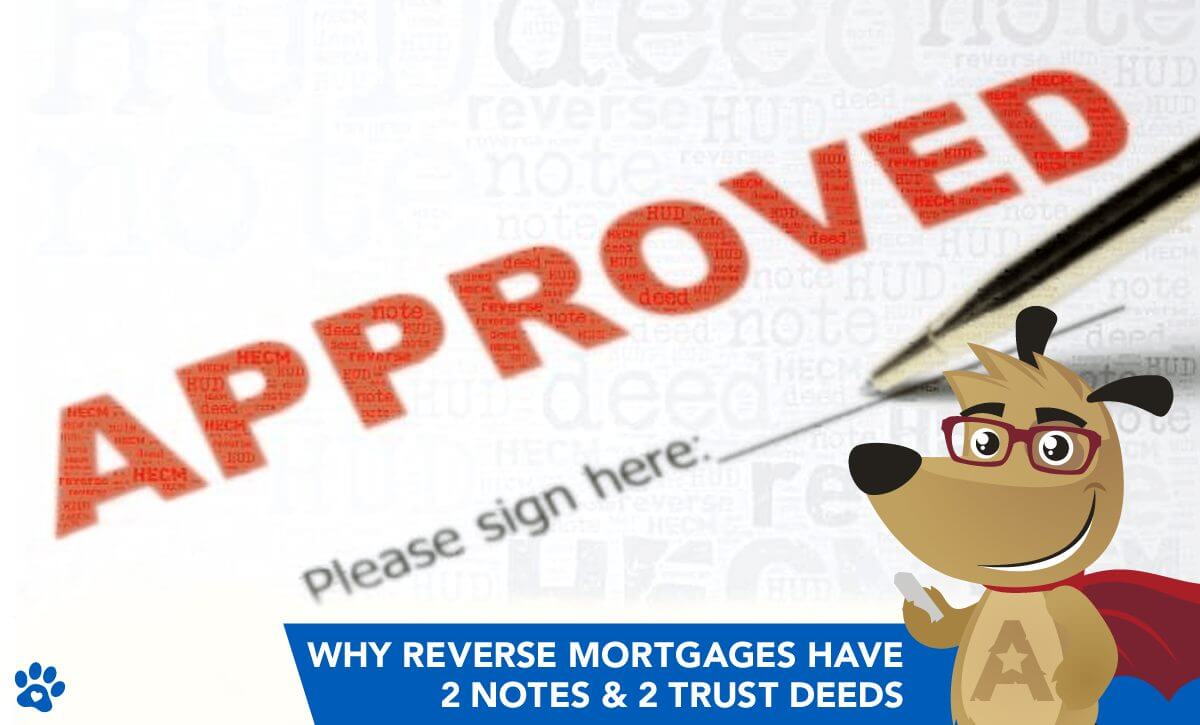Why Reverse Mortgages Have 2 Notes & 2 Trust Deeds
 |
Michael G. Branson, CEO of All Reverse Mortgage, Inc., and moderator of ARLO™, has 45 years of experience in the mortgage banking industry. He has devoted the past 20 years to reverse mortgages exclusively. (License: NMLS# 14040) |
 |
All Reverse Mortgage's editing process includes rigorous fact-checking led by industry experts to ensure all content is accurate and current. This article has been reviewed, edited, and fact-checked by Cliff Auerswald, President and co-creator of ARLO™. (License: NMLS# 14041) |
Borrowers often encounter confusion as they approach the crucial moment of signing their final documents for a reverse mortgage. They are introduced to a First and Second Trust Deed Note and Two Deeds of Trust (or mortgage, depending on the state laws applicable to the property).
Compounding the complexity, the amounts specified on the Note and Deed of Trust can be substantially higher than the sum the borrowers agreed to borrow. This discrepancy has led some borrowers to hesitate or even refuse to sign the documents at closing, primarily because they were not previously informed about the existence of multiple documents and the variances in the amounts stated.
In this article, we aim to shed light on the reasons behind the requirement for two deeds and two notes in the reverse mortgage process. Understanding the necessity for multiple documents and the rationale behind the differing amounts can significantly ease the concerns of borrowers.
Continue reading to explore the intricacies of these requirements and how they serve to protect the interests of all parties involved in a reverse mortgage transaction.

How Reverse Mortgages Are Recorded
When reading the manual on reverse mortgages, HUD explains that every reverse mortgage shall have both a First and Second Note, and while the borrower does not have to receive a copy of the Second Note before closing, its existence and relationship should be fully explained to the borrower (and thus this explanation to you).
The Second Note is not a separate loan encumbering the property as a traditional first and second loan. Instead, it secures any payments made to the borrower by HUD on their reverse mortgage. It “picks up,” if you will, where the payments made to the borrower or on the borrower’s behalf by the lender left off and those made by HUD start.
HUD Uses the Second Note For Your Protection
HUD can step into a reverse mortgage in a couple of instances and may advance funds on the part of the borrower. If the lender cannot make payments due to the borrower under the Loan Agreement, then HUD would step in and ensure that the borrower is paid.
In the case of a lender who becomes insolvent when borrowers depend on their reverse mortgage funds, HUD steps in and pays those funds to borrowers. This is one of the reasons why reverse mortgages have insurance.
HUD requires lenders to assign loans to them when the Loan to Value reaches 95%. From then on, HUD would make all future advances to the borrowers and may sometimes have to advance funds for taxes or insurance.
The second Note and Deed of Trust ensure that HUD’s position is covered under these circumstances, allowing them to continue to make any necessary advances to borrowers without the security they could not make.

How the HECM Note & Deed are Calculated
Next is the issue of the loan amount listed on the documents. HUD does not require a maximum mortgage amount to be stated on the mortgage because no payments are required. Many reverse mortgages have growth features in the lines available, and the balance owed increases as borrowers make no payments.
However, most states require an amount to be stated on the documents, leading to HUD’s dilemma. They cannot simply state the beginning balance as is the case with a typically amortizing loan or where a borrower’s borrowing power may increase with a growth rate on the line of credit or no amounts higher than this balance could be advanced to or on behalf of the borrower.
In cases such as tenure loans (payments for life) where borrowers continue to live in the home longer than the anticipated time frame, this would cause an abrupt stoppage of the payments, which would not be suitable for borrowers who depended on those monthly payments to live. Also, as is the case with the line of credit that grows over time on the unused portion, HUD states that a maximum amount stated as the beginning balance would prevent borrowers from using the growth balance of the line.
For this reason, the amount you will see on the Note and Deed (or Mortgage) will equal 150% of the Maximum Claim Amount, the total value of the property, or the HECM Lending Limit, whichever is less.
For example, if your home is worth $200,000, then the amount on the Deed would be $300,000 ($200,000 x 150%). If your home is worth $800,000, the amount on the Deed would currently be $1,200,000, and if your home value were to be at or above the current lending limit of $1,249,125, the amount on the deed would be $1,724,737.50.
Bottom Line: You Only Owe What You Borrow
This concept is the same as a Home Equity Line of Credit (HELOC). When you close the loan, you sign documents for the entire amount. Still, you only have to repay the amount you borrow plus interest on that amount, not the entire line, if you use only some of it. The big difference is that with the reverse mortgage, there is an additional Note and Deed in case HUD also has to advance funds.
But it’s still the same – you only repay what you borrow plus the fees and interest that you financed (and any funds that the lender or HUD have to advance on your behalf, such as taxes, insurance, etc., if those are not paid in a timely manner).
So these are the things you need to know about reverse mortgage documents before it’s time to sign:
- There will be 2 Notes and 2 Deeds of Trust (or Mortgages).
- They do not secure a First and Second Lien. The second Note and Deed only secure any advances HUD may have to make to you after the lender stops and HUD begins.
- The loan amount on the documents will either be blank, total 150% of your property value or 150% of the HUD Lending Limit, whichever is less, depending on the state in which you live and their laws affecting the mortgage documents, but if an amount is stated, it will be higher than the amount of cash you are receiving at the close.
Regardless of the amount stated on the loan documents, just like HELOC documents, you only owe what you borrow plus applicable interest, mortgage insurance, financing fees, and any amounts the lender or HUD has to advance on your behalf.
You will receive a sample copy of the Note, the Deed of Trust, or the Mortgage and Security Agreement in your loan package. If you have any questions, please do not hesitate to ask so that you are not surprised at your closing.
Top FAQs
Why are there two deeds of trust for a reverse mortgage?
Who holds the Deed on a reverse mortgage?
Does a reverse mortgage have a note?
Can you deed transfer if you have a reverse mortgage?
Does a reverse mortgage show on the title?
Can you get a second mortgage lien after getting a reverse mortgage?
Is there a time limit from when the deed was put in my name before getting a reverse mortgage?
ARLO recommends these helpful resources:

Have a Question About Reverse Mortgages?
Over 2000 of your questions answered by ARLO™
Ask your question now!




 Michael G. Branson
Michael G. Branson Cliff Auerswald
Cliff Auerswald

November 7th, 2024
November 7th, 2024
March 22nd, 2024
March 25th, 2024
December 26th, 2023
December 28th, 2023
December 8th, 2023
December 8th, 2023
November 24th, 2023
December 4th, 2023
November 22nd, 2023
November 22nd, 2023
September 29th, 2023
September 29th, 2023
August 30th, 2023
September 3rd, 2023
July 13th, 2023
July 14th, 2023
June 9th, 2023
June 9th, 2023
May 2nd, 2023
May 6th, 2023
October 24th, 2022
October 30th, 2022
October 4th, 2022
October 4th, 2022
September 6th, 2022
September 6th, 2022
April 2nd, 2022
April 2nd, 2022
January 25th, 2021
January 25th, 2021
November 11th, 2020
November 11th, 2020
October 22nd, 2020
October 22nd, 2020
June 25th, 2020
June 26th, 2020
June 2nd, 2020
June 3rd, 2020
April 20th, 2020
April 20th, 2020
March 15th, 2020
March 19th, 2020
March 9th, 2020
March 9th, 2020
August 25th, 2019
August 25th, 2019
March 30th, 2019
March 30th, 2019
January 1st, 2019
January 2nd, 2019
June 7th, 2024
June 8th, 2024
February 11th, 2017
February 13th, 2017
November 10th, 2016
June 21st, 2012
April 25th, 2012